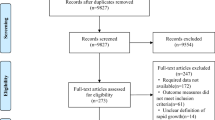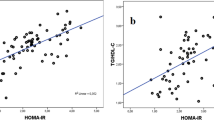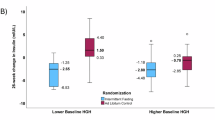Abstract
To determine whether hyperinsulinemia and reduced insulin sensitivity in individuals born small for gestational age (SGA) could be related to persisting abnormalities of the GH/IGF-I axis, we assessed overnight GH secretory profiles and measured fasting glucose, insulin, intact and 32,33 split proinsulin, and IGF-I levels in 16 short SGA children (age range 2.3–8.0 y) and in controls. Insulin sensitivity was calculated using the homeostasis model. Compared with short normal-birthweight controls (n = 7, age range 2.3–5.0 y), short SGA children had higher fasting insulin levels (means: 26.8 vs 20.6 pmol/L, p = 0.02), lower insulin sensitivity [means: 204 vs 284 %homeostasis model assessment (HOMA), p = 0.01], and higher beta cell function (112 vs 89 %HOMA, p = 0.04). SGA children also had lower levels of IGFBP-1 (87.0 vs 133.8, p = 0.04), but similar IGF-I levels (IGF-I SDS: -1.1 vs-1.7, p = 0.4). Compared with normal-height controls (n = 15, age range 5.6–12.1 y), SGA children had higher overnight GH secretion (GH maximum: 55.9 vs 39.6 mU/L, p = 0.01; mean: 13.1 vs 8.9, p = 0.004; minimum: 1.2 vs 0.6, p = 0.02). Interestingly, among SGA children, fasting insulin levels and insulin sensitivity were significantly related to overnight GH secretion (insulin sensitivity vs maximum GH: r = −0.68, p = 0.01;vs GH pulse amplitude r = −0.71, p = 0.007). The only hormone level significantly related to current height velocity was C-peptide (r = 0.75, p = 0.008). In conclusion, elevated fasting insulin levels and reduced insulin sensitivity in short SGA children was related to elevated levels of overnight GH secretion. We hypothesize that resistance to the somatotropic actions of GH and IGF-I in short SGA children may contribute directly to reduced insulin sensitivity.
Similar content being viewed by others
Log in or create a free account to read this content
Gain free access to this article, as well as selected content from this journal and more on nature.com
or
Abbreviations
- SDS:
-
SD score
- SGA:
-
small for gestational age
- HOMA:
-
homeostasis model assessment
- IGFBP-1:
-
IGF binding protein-1
References
Economides DL, Nicolaides KH, Campbell S 1991 Metabolic and endocrine findings in appropriate and small for gestational age fetuses. J Perinat Med 19: 97–105
Economides DL, Proudler A, Nicolaides KH 1989 Plasma insulin in appropriate- and small-for-gestational-age fetuses. Am J Obstet Gynecol 160: 1091–1094
Lassarre C, Hardouin S, Daffos F, Forestier F, Frankenne F, Binoux M 1991 Serum insulin-like growth factors and insulin-like growth factor binding proteins in the human fetus. Relationships with growth in normal subjects and in subjects with intrauterine growth retardation. Pediatr Res 29: 219–225
Giudice LC, de Zegher F, Gargosky SE, Dsupin BA, de las Fuentes L, Crystal RA, Hintz RL, Rosenfeld RG 1995 Insulin-like growth factors and their binding proteins in the term and preterm human fetus and neonate with normal and extremes of intrauterine growth. J Clin Endocrinol Metab 80: 1548–1555
Leger J, Oury JF, Noel M, Baron S, Benali K, Blot P, Czernichow P 1996 Growth factors and intrauterine growth retardation. I. Serum growth hormone, insulin-like growth factor (IGF)-I, IGF-II, and IGF binding protein 3 levels in normally grown and growth- retarded human fetuses during the second half of gestation. Pediatr Res 40: 94–100
de Zegher F, Kimpen J, Raus J, Vanderschueren Lodeweyckx M 1990 Hypersomatotropism in the dysmature infant at term and preterm birth. Biol Neonate 58: 188–191
Langford K, Blum W, Nicolaides K, Jones J, McGregor A, Miell J 1994 The pathophysiology of the insulin-like growth factor axis in fetal growth failure: a basis for programming by undernutrition?. Eur J Clin Invest 24: 851–856
Varvarigou A, Vagenakis AG, Makri M, Beratis NG 1994 Growth hormone, insulin-like growth factor-I and prolactin in small for gestational age neonates. Biol Neonate 1994 65: 94–102
Leger J, Noel M, Limal JM, Czernichow P 1995 Growth factors and intrauterine growth retardation. II—Serum growth hormone, insulin-like growth factor (IGF)-I, and IGF-binding protein 3 levels in children with intrauterine growth retardation as compared with normal controls: prospective study from birth to two years of age. Pediatr Res 40: 101–107
Ogilvy Stuart AL, Hands SJ, Adcock CJ, Holly JM, Matthews DR, Mohamed Ali V, Yudkin JS, Wilkinson AR, Dunger DB 1998 Insulin, insulin-like growth factor I (IGF-I), IGF-binding protein-1, growth hormone, and feeding in the newborn. J Clin Endocrinol Metab 83: 3550–3557
Savage MO, Woods KA 1996 The investigation of growth hormone insensitivity. Clin Endocrinol Oxf 45: 257–260
Cance-Rouzaud A, Laborie S, Bieth E, Tricoire J, Rolland M, Grandjean H, Rochiccioli P, Tauber M 1998 Growth hormone, insulin-like growth factor-I and insulin-like growth factor binding protein-3 are regulated differently in small-for-gestational-age and appropriate-for-gestational-age neonates. Biol Neonate 73: 347–355
Fitzhardinge PM, Inwood S 1989 Long-term growth in small-for-date children. Clin Endocrinol Oxf 349: 27–33
Karlberg J, Albertsson Wikland K 1995 Growth in full-term small-for-gestational-age infants: from birth to final height. Pediatr Res 38: 733–739
Leger J, Limoni C, Czernichow P 1997 Prediction of the outcome of growth at 2 years of age in neonates with intra-uterine growth retardation. Early Hum Dev 48: 211–223
Thieriot-Prevost G, Boccara JF, Francoual C, Badoual J, Job JC 1988 Serum insulin-like growth factor 1 and serum growth-promoting activity during the first postnatal year in infants with intrauterine growth retardation. Pediatr Res 24: 380–383
de Waal WJ, Hokken-Koelega AC, Stijnen T, de MuinckKeizer-Schrama SM, Drop SL 1994 Endogenous and stimulated GH secretion, urinary GH excretion, and plasma IGF-I and IGF-II levels in prepubertal children with short stature after intrauterine growth retardation. Clin Endocrinol (Oxf) 41: 621–630
Boguszewski M, Jansson C, Rosberg S, Albertsson Wikland K 1996 Changes in serum insulin-like growth factor I (IGF-I) and IGF- binding protein-3 levels during growth hormone treatment in prepubertal short children born small for gestational age. J Clin Endocrinol Metab 81: 3902–3908
Boguszewski M, Rosberg S, Albertsson Wikland K 1995 Spontaneous 24-hour growth hormone profiles in prepubertal small for gestational age children. J Clin Endocrinol Metab 80: 2599–2606
Rochiccioli P, Tauber M, Moisan V, Pienkowski C 1989 Investigation of growth hormone secretion in patients with intrauterine growth retardation. Acta Paediatr Scand Suppl 349: 42–46
Stanhope R, Ackland F, Hamill G, Clayton J, Jones J, Preece MA 1989 Physiological growth hormone secretion and response to growth hormone treatment in children with short stature and intrauterine growth retardation. Acta Paediatr Scand Suppl 349: 47–52
Barker DJ, Hales CN, Fall CH, Osmond C, Phipps K, Clark PM 1993 Type 2 (non-insulin-dependent) diabetes mellitus, hypertension and hyperlipidaemia (syndrome X): relation to reduced fetal growth. Diabetologia 36: 62–67
Barker DJ, Gluckman PD, Godfrey KM, Harding JE, Owens JA, Robinson JS 1993 Fetal nutrition and cardiovascular disease in adult life. Lancet 341: 938–941
Phillips DI, Barker DJ, Hales CN, Hirst S, Osmond C 1994 Thinness at birth and insulin resistance in adult life. Diabetologia 37: 150–154
Yajnik CS, Fall CH, Vaidya U, Pandit AN, Bavdekar A, Bhat DS, Osmond C, Hales CN, Barker DJ 1995 Fetal growth and glucose and insulin metabolism in four-year-old Indian children. Diabet Med 12: 330–336
Hofman PL, Cutfield WS, Robinson EM, Bergman RN, Menon RK, Sperling MA, Gluckman PD 1997 Insulin resistance in short children with intrauterine growth retardation. J Clin Endocrinol Metab 82: 402–406
Bratusch Marrain PR, Smith D, DeFronzo RA 1982 The effect of growth hormone on glucose metabolism and insulin secretion in man. J Clin Endocrinol Metab 55: 973–982
Moller N, Butler PC, Antsiferov MA, Alberti KG 1989 Effects of growth hormone on insulin sensitivity and forearm metabolism in normal man. Diabetologia 32: 105–110
Laager R, Ninnis R, Keller U 1993 Comparison of the effects of recombinant human insulin-like growth factor-I and insulin on glucose and leucine kinetics in humans. J Clin Invest 92: 1903–1909
Soliman AT, Hassan AE, Aref MK, Hintz RL, Rosenfeld RG, Rogol AD 1986 Serum insulin-like growth factors I and II concentrations and growth hormone and insulin responses to arginine infusion in children with protein-energy malnutrition before and after nutritional rehabilitation. Pediatr Res 20: 1122–1130
Clayton KL, Holly JM, Carlsson LM, Jones J, Cheetham TD, Taylor AM, Dunger DB 1994 Loss of the normal relationships between growth hormone, growth hormone-binding protein and insulin-like growth factor-I in adolescents with insulin-dependent diabetes mellitus. Clin Endocrinol (Oxf) 41: 517–524
Freeman JV, Cole TJ, Chinn S, Jones PRM, White EM, Preece MA 1995 Cross sectional stature and weight reference curves for the UK. Arch Dis Child 73: 17–24
Edge JA, Dunger DB, Matthews DR, Gilbert JP, Smith CP 1990 Increased overnight growth hormone concentrations in diabetic compared with normal adolescents. J Clin Endocrinol Metab 1990: 71: 1356–1362
Matyka KA, Dunger DB 1999 Counterregulation during spontaneous nocturnal hypoglycaemia in prepubertal children with type 1 diabetes. Diabetes Care 22: 1144–1150
Sobey WJ, Beer SF, Carrington CA, Clark PM, Frank BH, Gray IP, Luzio SD, Owens DR, Schneider AE, Siddle K 1989 Sensitive and specific two-site radioimmunometric assays for human insulin, proinsulin, 65–66 and 32,33 split proinsulin. Biochem J 260: 535–541
Helle SI, Anker GB, Meadows KA, Holly JM, Lonning PE 1998 Alterations in the insulin-like growth factor system during the menstrual cycle in normal women. Maturitas 28: 259–265
Matthews DR, Hosker JP, Rudenski AS, Naylor BA, Treacher DF, Turner RC 1985 Homeostasis model assessment: insulin resistance and beta-cell function from fasting plasma glucose and insulin concentrations in man. Diabetologia 28: 412–419
Blum WF 1992 Insulin-like growth factors and their binding proteins. In: Ranke MB (ed) Functional Endocrinologic Diagnosis in Children and Adolescents. JJ Verlag, Mannheim, pp 102–117.
Ackland FM, Stanhope R, Eyre C, Hamill G, Jones J, Preece MA 1988 Physiological growth hormone secretion in children with short stature and intra-uterine growth retardation. Horm Res 30: 241–245
Chatelain PG, Niccolino M, Claris O, Salle B, Chaussain JL 1998 Multiple hormone resistance in short children born with intrauterine growth retardation?. Horm Res 49: 20–22
de Zegher F, Maes M, Gargosky SE, Heinrichs C, Du Caju MV, Thiry G 1996 High-dose growth hormone treatment of short children born small for gestational age. J Clin Endocrinol Metab 81: 1887–1892
de Zegher F, Francios I, van Helvoirt M, van den Berghe G 1997 Small as a fetus and short as a child: from endogenous to exogenous growth hormone. J Clin Endocrinol Metab 7: 2021–2026
Stanhope R, Preece MA, Hamill G 1991 Does growth hormone treatment improve final height attainment of children with intrauterine growth retardation?. Arch Dis Child 66: 1180–1183
Berneis K, Keller U 1996 Metabolic actions of growth hormone: direct and indirect. In: Ross RJM, Savage MO (eds) Growth Hormone Resistant States. Ballière-Tindall, London, pp 337–352.
Brook CJD 1973 Effect of human growth hormone treatment on adipose tissue in children. Arch Dis Child 48: 725–728
Woods KA, Savage MO 1996 Laron syndrome: typical and atypical forms. In: Ross RJM, Savage MO (eds) Growth Hormone Resistance. Ballière Tindall, London, pp 371–388.
Scacchi M, Pincelli AI, Caumo A, Tomasi P, Delitala G, Baldi G, Cavagnini F 1997 Spontaneous nocturnal growth hormone secretion in anorexia nervosa. J Clin Endocrinol Metab 82: 3225–3229
Rosenfeld RG, Wilson DM, Dollar LA, Bennett A, Hintz RL 1982 Both human pituitary growth hormone and recombinant DNA-derived human growth hormone cause insulin resistance at a postreceptor site. J Clin Endocrinol Metab 54: 1033–1038
Piatti PM, Monti LD, Caumo A, Conti M, Magni F, Galli-Kienle M, Fochesato E, Pizzini A, Baldi L, Valsecchi G, Pontiroli AE 1999 Mediation of the hepatic effects of growth hormone by its lipolytic activity. J Clin Endocrinol Metab 84: 1658–1663
Tamemoto H, Kadowaki T, Tobe K, Yagi T, Sakura H, Hayakawa T, Terauchi Y, Ueki K, Kaburagi Y, Satoh S 1994 Insulin resistance and growth retardation in mice lacking insulin receptor substrate-1. Nature 372: 182–186
Terauchi Y, Iwamoto K, Tamemoto H, Komeda K, Ishii C, Kanazawa Y, Asanuma N, Aizawa T, Akanuma Y, Yasuda K, Kodama T, Tobe K, Yazaki Y, Kadowaki T 1997 Development of non-insulin-dependent diabetes mellitus in the double knockout mice with disruption of insulin receptor substrate-1 and beta cell glucokinase genes. Genetic reconstitution of diabetes as a polygenic disease. J Clin Invest 99: 861–866
Acknowledgements
The authors thank Professor CN Hales for measuring the intact and 32,33 split proinsulin levels and Karin Van Wesen RN for logistic assistance in performing the study.
Author information
Authors and Affiliations
Corresponding author
Additional information
The authors thank Pharmacia Upjohn for their generous support in this study. M.V.H was supported by a visiting scholarship from the European Society for Paediatric Endocrinology, and F.D.Z is a Clinical Research Investigator of the Fund for Scientific Research, Flanders, Belgium.
Rights and permissions
About this article
Cite this article
Woods, K., Van Helvoirt, M., Ong, K. et al. The Somatotropic Axis in Short Children Born Small for Gestational Age: Relation to Insulin Resistance. Pediatr Res 51, 76–80 (2002). https://doi.org/10.1203/00006450-200201000-00014
Received:
Accepted:
Issue date:
DOI: https://doi.org/10.1203/00006450-200201000-00014
This article is cited by
-
The Auxological and Metabolic Consequences for Children Born Small for Gestational Age
Indian Journal of Pediatrics (2021)
-
Human conditions of insulin-like growth factor-I (IGF-I) deficiency
Journal of Translational Medicine (2012)
-
Association between height and weight catch-up growth with insulin resistance in pre-pubertal Chinese children born small for gestational age at two different ages
European Journal of Pediatrics (2011)
-
Clinical utility of measurements of insulin-like growth factor 1
Nature Clinical Practice Endocrinology & Metabolism (2006)
-
Fetal Origins of Adult Disease: A Paediatric Perspective
Reviews in Endocrine and Metabolic Disorders (2005)



